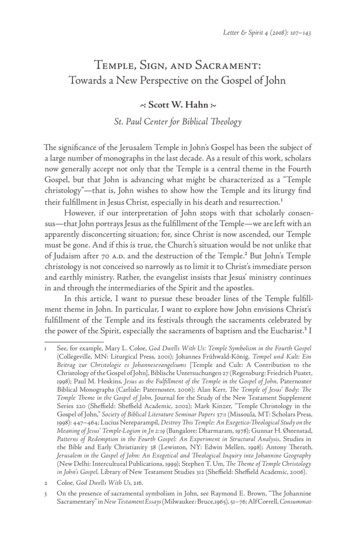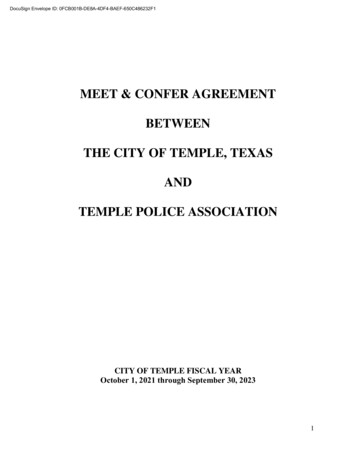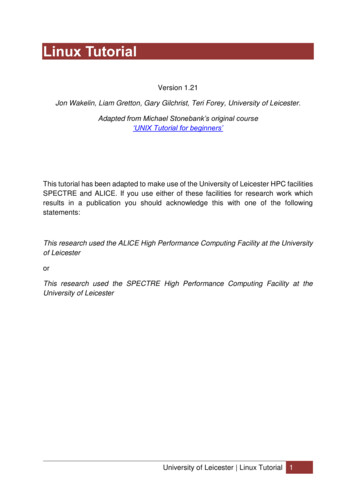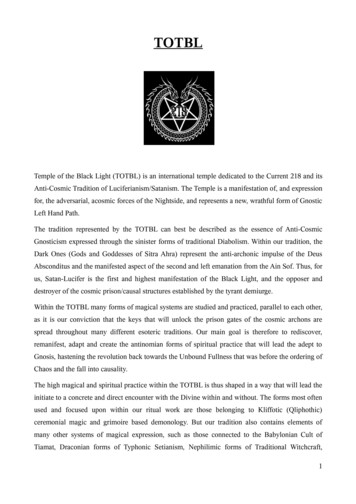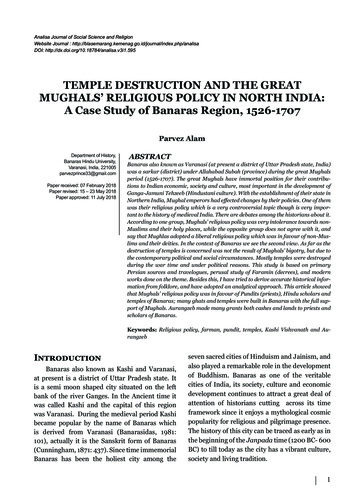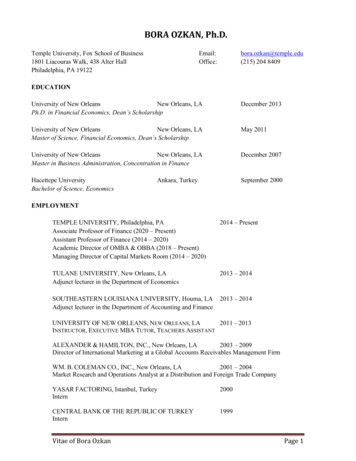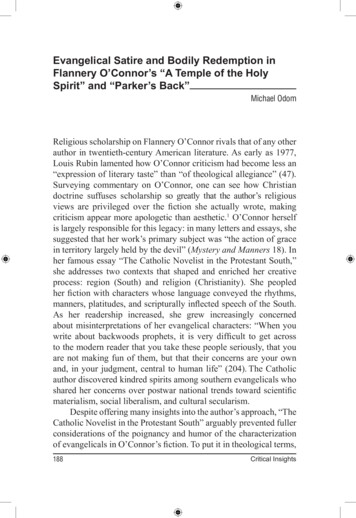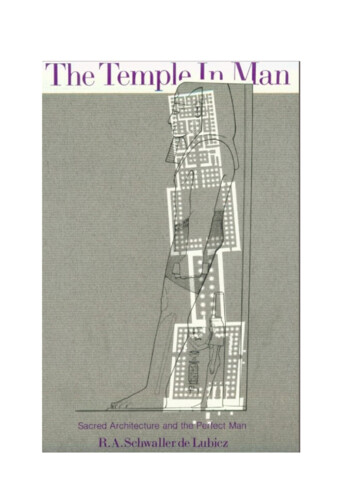
Transcription
The Temple in ManSacred Architecture and the PerfectManR.A. Schwaller de LubiczTranslated byRobert & Deborah LawlorIllustrated by Lucie Lamy
Table of ContentsPAGETranslator's Foreword .7Preface .14Introduction .16Definitions .27CHAPTER I. A Hypothesis and Its Evolution. 33CHAPTER II. Significanceof the Crown of the Skull.48CHAPTER III. Reflectionson a Philosophy of Measure .57CHAPTER IV. The Plan .68CHAPTER V. Orientation .80CHAPTER VI. The Temple in Man .86CHAPTER VII. The Crossing: Egyptian Mentality .111CHAPTER VIII. The Egyptian Canonfor a Standing Man .115Conclusions .132
Translator's ForewordTHE APPEARANCE of this small book in 1949 created an unusuallylarge academic controversy in the renowned Department of Egyptology of the College de France, Paris. An "amateur" Egyptologist(as the scholars must have labeled Schwaller de Lubicz) hadpresented an entirely new and radical approach for the consideration of Egyptologists, archaeologists, and historians in general, anapproach that might have been ignored completely had it not beendeveloped with such a great amount of forceful, detailed research,and had it not won over the complete acceptance and enthusiasmof several of the leading Egyptologists and archaeologists of thattime, including Alexandre Varille and C.H. Robichon. We shall notgo into the intriguing way in which the academic establishment circumvented a confrontation with the challenge posed by Le Templedans l'Homme; nor shall we examine how they attempted to dismissthis work through the well-known academic tactic of intentionalsilence. Instead, let us use these few pages to introduce this relatively little known author, then to see what might be some of themajor themes contained in the "New Egyptology" that Schwallerde Lubicz's work opens before us.It is true that Schwaller de Lubicz was not a qualified Egyptologist by academic standards. Instead of first spending years inthe Egyptological libraries of Europe, he, upon his first visit toEgypt, took up residence together with his family1 in a small hotel1His wife, Isha Schwaller de Lubicz, a specialist in Egyptian hieroglyphic language, later wrote atwo-volume novel depicting life in ancient Egypt through the eyes of a young man who attains thelevel of temple initiation. In Her-Bak Chirk Pea (Inner Traditions. 1979) and Her-Bak: TheLiving Face of Ancient Egypt (Inner Traditions. 1978) she utilizes philosophic inspiration andresearch material from her husband's work. His stepdaughter Lucie Lamy carried out theexacting survey of the entire temple.7
very near the Temple of Luxor, and there he remained For morethan fifteen years of intense, uninterrupted study of this greatmonument of the Eighteenth Dynasty of pharaonic Egypt.Schwaller de Lubicz was already a mature man by the time hearrived in Egypt. Let us therefore review briefly his earlier years.2At about eighteen years of age. Rene Schwaller left his home inAlsace, after having completed an apprenticeship with his father inpharmaceutical chemistry, and went to Paris with the clearlyformulated intention of "learning the true nature of substance." Inaddition to studying modern chemistry and physics, at this youngage he began reading every alchemical text he could find, those ofthe thirteenth and fourteenth centuries as well as sixteenth-centuryRosicrucian texts and the more familiar works of Paracelsus andRaymond Lull. For a period he became interested in painting andwas a student of Matisse, but his main role among his contemporaries was that of a philosopher of nature; thus, he influencedmany artists in Paris at that time, such as Arp, Leger, andespecially Prince O.V. de Lubicz Milosz, the Lithuanian mysticpoet and statesman, who in 1919 conferred his family title onSchwaller as a means of expressing his admiration and gratitude.He served in the armed forces as a chemist during the FirstWorld War, and at the close of the war he published a journal,L'Affranchi, followed by Le Veilleur, both dedicated to social reformin the difficult task of implementing peace.During the course of his personal development, he received thename of "Aor," signifying "Light of the Higher Mind." He is saidto have continued his alchemical research during this period, andlater, while living among and guiding a contemplative communityof students, scholars, artists, and craftsmen who had gatheredaround him at. St. Moritz in the Swiss Alps, he producedalchemical glass with reds and blues thought to compare with thestained glass of Chartres Cathedral, a feat no other chemist hasbeen able to accomplish in the six hundred years since thecathedrals were constructed. It was during the years at St. Moritzthat his philosophic and scientific vision coalesced around anunderstanding of the universal laws of harmony.2For a more complete biographical account, see AOR, Sa vie, Son oeuvre by IshaSchwaller de Lubicz (Paris: La Colombe, 1963), and Serpent in the Sky: A Study ofthe Work of Schwaller de Lubicz by J. A. West (New York: Harper & Row, 1978).8
Thus, it might be said that Schwaller de Lubicz's preparation forEgypt was that of a philosopher, in the sense that his entire lifeconstituted an intense philosophical inquiry. His unique andintuitive way of seeing, in combination with a technical and scientific education, gave him his extraordinary insight into the valuesand objectives motivating ancient science and theology.In Schwaller de Lubicz's scrupulous examination of the an andarchitecture of the Temple of Luxor, at least two concurrent levelsare being developed at any given point. One is the study of Egyptas a civilization that existed in a factual geographic place and time(including its people, mythology, social forms, its chronologicalunfolding, its monuments and artifacts), but this level is only abackdrop, or support, for another Egypt which might be defined asa "quality of intelligence." This is Egypt as an evocation of a particular utilization and expression of a universal power of higherintellection. This Egypt is outside of chronological considerations; itis, rather, both an ever present and a recurring possibility of consciousness. In his approach to Egypt, Schwaller de Lubicz stressesthe view that in order to comprehend the significance of aheightened phase among man's varied historical expressions, weneed to impose on ourselves the discipline of attempting to enterinto the mentality of the people and the spirit of the time. To do sowould mean more than just learning the language and symbols ofthe period under study; we must also awaken in ourselves a livinginner rapport with the material being researched and identify withit in a potentially self-transforming manner. Of course, this idealcan never be fully attained, as our present consciousness isinevitably with us, but, on the other hand, by continuing to sift allof history through our present rationalized, individualized psychological mentality, we distort beyond recognition the content andmeaning of the past. This distortion often occurs when we try tointerpret the great mythological cultures of Egypt or Vedic India inparticular; we tend to lose sight of the fact that these cultures wereexpressing a different mentality, and values, from ours and thatthey had a completely different understanding of the goal and purpose of life. As a result, in all of their science, art, and knowledgethese cultures used distinct modes and methods of symbolization.Schwaller de Lubicz found it necessary to inquire into the nature of9
symbolization itself in order even to arrive at an understanding ofwhat a heiroglyph is. This he carried out in two small books, Propossur Esoterisme el Symbole (Esotericism and Symbol) and Symbole etSymbolique (The Symbol and the Symbolic), English translations ofwhich are forthcoming from Autumn Press.That these ancient peoples thought differently than we do—andthat we must understand this difference if we are to study themproperly—seems obvious, but an example will show how difficult itis to put this idea into practice. Schwaller de Lubicz explains in LeTemple de l'Homme (Caracteres, 1957) that in the ancient templecivilization of Egypt, numbers, our most ancient form of symbol,did not simply designate quantities but instead were considered tobe concrete definitions of energetic formative principles of nature.The Egyptians called these energetic principles Neters, a wordwhich is conventionally rendered as "gods.""In considering the esoteric meaning of Number, we mustavoid the following mistake: Two is not One and One; itis not acomposite. It is the multiplyingWork; it is thenotion of the plus in relation to the minus;itis a newUnity; it is sexuality; it is the origin of Nature. Physis, theNeter Two. It is the Culmination (the separating momentof the full moon, for example); it is the line, the stick,movement, the way, Wotan, Odin, the Meter Thoth, Mercury,Spirit."Also, when the ancients considered the process of mathematicalmultiplication, their mode of calculation had a direct relationshipwith natural life processes as well as metaphysical ones. Schwallerde Lubicz called this mode the "principle of the crossing" (interestingly, we today continue to symbolize multiplication with the sign of across: X). This crossing was not a sterile, mental, numerical manipulation but a symbol for the process by which things enter intocorporeal existence. All birth into nature requires a crossing of opposites. It can be the crossing of vertical and horizontal lines, which givebirth to the square, the first measurable surface; or male and female,giving birth to a new individual; or warp and weft, creating a fabric;or light, and darkness, giving birth to tangible forms; or matter andspirit, giving birth to life itself. Thus the vital linking up of the mentalabstraction of calculation with its counterpart in natural phenomenagave the ancient mathematician a living and philosophic basis for hisscience.10
Similarly, these ancienl peoples did not use words as we do, thatis, as symbols or sounds linked together, which have fixed,memorized associations and which we compose in sequentialpatterns within the mind. For them words were of a musicalnature; or, more precisely, speaking was a process of generatingsonar fields establishing an immediate vibratory identity with theessential principle that underlies any object or form. The pharaonicintelligence that Schwaller de Lubicz reveals to us was not thevisualizing, analytical mentality we know but a sonar-intuitionalmode. In the Egyptian temple, wrote Caspar Maspero, the human voice istheinstrumentparexcellenceofthepriest and the enchanter. It is the voice which seeks afarthe Invisibles summoned and makes the necessary objectsinto a reality. . . .But as every one (of the tones) has itsparticular force, great care must be taken not to rly, this approach to Egyptology demands a qualitativechange on our part if we are to enter into the pharaonic spirit. Andthis change in our thinking may offer us perspective not only on thevastly different intelligence of the past but on the limitations andexcesses of our present intellect as well.This meticulous meditation on the stones and statuary of Luxoralso raises far-reaching questions on the function and nature ofhistory itself. In particular we begin to see that Egypt may have leftus some essential keys to help us find our way toward an integration of things metaphysical (spirit), mathematical (mental, scientific), musical (vibrational, living) and physiological (physical ormaterial). As a civilization, Egypt certainly holds up to us a modelof this reintegrated expression of the various planes and parts ofour individual natures and of the cosmic life of our universe, andthus may prove of greater value in the spiritual crisis now confronting us than the religions of transcendence adapted fromvarious ancient Eastern cultures. Egypt was not of the lineage thatadvocates transcendence and denial of material existence; it taught,rather, transformation. The ancient name for Egypt was "Kemi,"meaning "Black Earth," the field of vital transformation; theArabs, Schwaller de Lubicz points out, called Egypt "Al-Kemi."3As quoted in Henry George Farmer, "The Music of Ancient Egypt," The NewOxford History of Music (London, Oxford University Press, 1957) p. 259.11
Thus we find in its very name that age-old, universal doctrine sooften disguised in symbols and parables. This doctrine encompassesa vision of the principle of matter as a field of existence responsiveto and capable of being transformed by spiritual influences broughtabout through the evolution of embodied and individualized consciousness. The West today could benefit from a philosophy ofspiritual depth that does not suppress, diminish, or deny our intellectual and material nature but rather fulfills our commitment, tothe meaningfulness of human life and this material expression ofthe universe.This lost alchemy, the pursuit, of which extends back to its flowering in ancient Egypt, can be seen as the hidden esoteric roots ofboth civilization and individuals throughout recorded time. It is thissame alchemy which is at the core of the vision of theanthropocosm—of Man as being and containing within himself theentire universe. This vision, which is introduced by Schwaller deLubicz in these pages and expanded and brought to life in hismajor work, The Temple of Man, leaves us with a single, enduringmessage: the inevitable resurrection of the spiritual essence whichhas involved itself in matter in the form of organic creative energy.This resurrection depends upon the transformation of the materialuniverse—or to express the idea more as Egypt left it imprinted inthe stones of Luxor: the birth of divine man (symbolized by thepharaoh) depends upon the transformation of the universal mother(materia prima). This transformation was considered the sole cosmicgoal. Every human birth participates in this alchemy, either in anawakened manner through the intentional perfecting and expression of one's higher nature, or unawakened, through the tumultand suffering of karmic experience leading eventually to a spiritualself-awareness, the temple in man. The intensification and heightening of human consciousness was believed to cause biological andeven cellular changes in the physical body of the initiate. Thisdivinization of the individual body, on the microcosmic level, comprised the goal and purpose of the evolution of human consciousness in general.Within the Temple of Egypt, psycho-spiritual growth was wedded to precise intellectual and physiological disciplines whichacted to accelerate the influence and transformative effects of spirit12
over matter. With Egyptian alchemy we arc considering, then, ascience in the highest sense of the word, and one very different fromour own. It was science directed toward the embodiment ofspiritual knowledge, toward the internalization and corporealexpression of intellectual and spiritual powers, rather than themechanistic utilization of knowledge-power for the exploitation andmanipulation of the earthly environment.The Temple was the pinnacle of the collective life, ever guidingthe energy of the long-lived civilization of the Nile Valley towardthe gestation of a divine humanity out of the transitory humanform.ROBERT LAWLOR13
PrefaceTHE PURPOSEof this book is to present indisputable evidence thata symbolic directive was operative in the architecture of the Templeof Luxor.I will examine esoteric symbolism and its significance in ancientEgypt in greater depth in a future book, the outline for which canalready be established on the basis of a wealth of. documentation.This material now allows us to affirm that what is true for theTemple of Luxor is also true for other monuments from all theEgyptian dynasties, the symbolism evidently having been adaptedto the particular consecration of an edifice and to the nature of theplace where it was erected.The findings presented here are the fruit of eight years of uninterrupted work carried out by Lucie Lamy, consisting of veryprecise surveys of the present layout and the bas-reliefs of the Temple of Luxor, and the notation of the measurements. ClementRobichon, architect and head of field work operations of the FrenchInstitute of Oriental Archaeology, was responsible for triangulationand for checking all the plans.Triangulation was carried out by means of a Saharan-type tandably, I feel moved, at the beginning of this work, tothank Egypt warmly for the hospitality it has shown me. In addition, the Department of Antiquities has been very helpful andunderstanding throughout.For a history of the excavations of the Temple of Luxor, thereader is referred to G. Daressy's "Notice Explicative des Ruinesdu Temple de Luxor" published in 1893.A study of detail is required almost uniformly. For this reason,14
we have established a new method of surveying by means of making precise drawings, with an exact notation of the outlines of thetableaux (the various "registers" or strata of images found on thewalls of Egyptian monuments) the figures, and their main accessories. All these data are included in the drawings in their correctproportions; complete records of their measurements are alsoprovided.Each drawing of an entire section, once recorded on microfilm,can be projected, thus enabling the exact correlation of separatelydrawn or carefully photographed texts or figure details with thewhole.Applying this method, a trained team of five or six people,guided by the principles I shall set forth in this book, could surveythe architecture and decoration of a temple such as that of Euxorin six months—a task that took us eight years.15
IntroductionEXCAVATIONS and philological studies supply the Egyptologistwith abundant material for a knowledge of (he life, beliefs, andtheology of ancient Egypt. An encyclopaedic amount of work isavailable to the researcher. Nevertheless, Pharaonic Egypt remainsunknown in terms of its true science, its contingent psycho-spiritualknowledge, and its philosophical mentality.The funerary texts develop t h e myth transcribed into images, butit has not been possible to translate the deeper meaning of theseimages into comprehensible language. The philosophical connectionof the accumulated data is lacking. One tends to seek in ancientEgypt, as well as in Babylon and other traditions of the past, whatmight be called a rational expression of esotericism. This is anerror that arises from the prejudice that there is no esotericism, orthat there exists an intent to conceal a certain knowledge.However, simple reasoning shows us that, for example, if theGospels were written to teach the way of Truth and to show uswhat this Truth consists of. then the form of parables and enigmatic phrases chosen for this revelation would be nonsensical if itspurpose were to conceal this Truth. The purpose of these parablesand enigmatical phrases is not to hide anything from "he who haseyes to see and ears to hear," according to the evangelical formula.The purpose is to select those who developed the necessary understanding and who are for this reason worthy of these "secrets"(that is to say. they will not misuse them for selfish motives). Therewas never any intent to conceal, from those thus prepared, any ofthe wisdom transmitted by texts, traditions, or monuments. Theenigma does not lie in the thing itself but is the result of our understanding, our faculties, and our intelligence, which arc not attuned16
to the mentality according to which the idea was expressed, and itis just this that our present education prevents us from admitting.However, there is a type of education that—using the vitalorgans in which the nervous flux is transformed as well as thecenters (or "nodes") of this flux—can awaken "consciousness" ofstates that precede and transcend material forms. The West has noterminology for this science, and thus we must have recourse to theoriental languages. But the words alone are useless without theconcepts. Ancient Egypt is in fact one of the major sources of thesesciences: however, a true vocabulary of the Pharaonic language—oreven a provisional one—will never be possible unless attention isgiven to those questions which we define as psycho-spiritual. TheEgyptian symbolism can guide us in this regard and show us meanings other than the common meanings currently accepted for agreat many words. In this way. the meaning of many texts willbecome clear.Rationalism is based on the data provided by the senses, and thesenses perceive only a meager part of what is. Thus, throughrationalism alone we can know only what is encountered throughthe senses, what is ponderable, quantitative. Yet mathematics havedemonstrated the existence of elements that fall outside thephysical; we must take this into account, and if rationalism bringsus up against an impenetrable wall, in so doing it in fact teaches usthat it has its limits and that we should seek another means ofknowledge.We express ourselves in a conventional language, and the dictionary defines and limits the meaning of each word. Therefore, wecan understand nothing beyond what the dictionary knows. Wewrite with conventional alphabetic signs that in themselves expressonly sounds; thus our alphabet is merely a mechanical means forcomposing the words in the dictionary and transmitting thethoughts they encompass. It may be said that the combinations ofthese letters are almost infinite: true, but the number of words islimited by notions already acquired. Thought can also examineobserved phenomena and seek the causes. . . . Certainly it can, butas soon as it approaches the metaphysical, it can no longer find inour languages and forms of writing the means of expressing itself:abstract ideas, formulated in words for which we lack the concepts,are objectified and lose their significance.17
It follows from these observations that either there exists only aconcrete world perceptible to the senses, or we lack a faculty thatwould enable us to grasp the abstract, without having to concretizethrough the imagination. The process is ingrained in us, in accordance with a mode that always leads toward the quantitativedefinition. This is the inverse of the Egyptian mentality.If an unknown phenomenon appears, it is already the concretization of a cause that was abstract for us. Instead of searching outthe nature of this cause, we obey our reductionist tendency andrestrict both cause and phenomenon to the realm of the mechanicalmentality. We investigate nothing deeply; we pull everything downto our own limits. However, a simple image proves to us that thereis a way we can express ourselves without limiting a notion to adefined form, and transcribe our thought without imposing our ownmentality on those who will read this image. We have gotten intothe habit of reducing everything in Time and Space: this is therational habit. An image, on the other hand, gives access to a worldof qualities and functions. For instance, if we say "a man walks,''we see a man walking, but we sec him in a limited way: we imagineonly the fact of moving or walking. We can then place that fact inthe past, present, or future and all the gradations of these tenses:we situate this movement in Time and Space. If, on the other hand,we see an image that represents a man walking (or simply linesdepicting a man) we no longer imagine him, we no longer situatehim; he is there, it is the function that interests us, and the qualityof that function. We can then paint this man green: it will nolonger be solely the function of walking with one's legs that isevoked—this movement could also signify vegetation or growth. Butto our reason, walking and growing are two different functions,while in reality there is an abstract connection between them: it ismovement outside consideration of Time, or pathway, or specificdirection.If we wish to define this movement, we immediately reduce it inTime and Space, whereas there is no further need to define the feeling of motion (whether walking or growing); the image—thesymbol—acts as definition, and we can in fact experience this condition (unconsciously become one with it, without any reasoning)just as any child would looking at pictures.18
Thus, the representation—the symbol—is our only true means oftransmitting an esoteric meaning, which, in alphabetic writing, wehave to seek in parable, or, possibly metaphor or allegory. TheChinese mentality is characteristic of this transcribed symbolicmentality: the idea is circumscribed but not named. Something ofthis mentality, which we encounter in the Egypt of the pharaohs,has remained among the peoples of the Middle East: the indirectquestion and answer.Symbolic representation and imagistic writing are the purehieratic forms of esoteric expression. Through symbolism, andthrough it alone can we read the thought of the Ancients. It is onlythrough the symbolical that we will be able to coordinate theknown elements of this great civilization and that the writing maytake on its true meaning.With regard to this mode of expression, I shall quote Ampere,Essai sur la Philosophic des Sciences (vol. 2, pp. oncereserved for a small number of initiates: and the secret ofthese ideas, though buriedwith them, can be rediscovered by those who study in depth all the types onies they prescribed. Hence, a science, given thename of 'the Symbolic' (the name I shall retain for it),proposes to uncover what was hidden behind such diverseemblems."I shall explain more precisely what I mean by the word symbol inthe chapter on "Definitions" and in the "Summary of Principles."We also see in the symbol the only means of making a connection between the "oriental" mentality and the "occidental" mentality, according to the basic distinction currently accepted. Butpharaonic Egypt—which is, in my opinion, the main source ofMediterranean civilization—is in some ways closer to us than is theOrient. Its mentality is positive, and its expression is symbolic, to convey a form of esotericism that does not differ from the others, sinceWisdom cannot vary if it is real.This symbolic aspect has been completely neglected in Egyptology. It is the proof of its existence, and of the directive stemmingfrom it in the pharaonic expression, that I find and present withthe Temple of Luxor.19
The strangely irregular plan of this temple prompted me toinvestigate the causes of these irregularities. Since this architectural conception was executed in several phases along the temple'slongitudinal axis, hitherto the simple explanation of attributingutilitarian purposes to successive builders has been adopted. In myopinion, only more profound reasons could have inspired theseextraordinary constructions, which certainly, on account of the veryeffort required, could not have been consecrated to inconsequentialideas. Many positive proofs and experiments now confirm thecorrectness of this way of thinking.Obviously, no one would build such monuments, and in suchgreat numbers, over thousands of years, for uncultivated peasants.This work is of necessity that of an elite, and, even more remarkably, an elite that never ceased to renew itself, an elite that seemsto have been uniquely endowed with a wealth of scientific knowledge, including an understanding of the laws of Life.What, then, was this inexhaustible source, and what means sopowerful and so stable assured such continuity?We are dealing here, not with an evolution of science, but rather,on the contrary, with an immutable basis: for the existence of alanguage and a form of writing that were already complete fromthe time of the earliest dynasties of the historical period seems toconfirm this. What we sec is not the beginnings of research, but theapplication of a Knowledge already possessed.*First of all, our team set out to survey the general plan of thetemple, then all its details with the greatest precision possiblewithout concerning ourselves with an explanation of the 1,001irregularities observed. I shall explain the outcome of this work inthe following pages.The first important thing, affording the true explanation of allthe idiosyncrasies, was the discovery of axes drawn on the platformof the covered temple. Aside from the axes drawn on the ground inthe sanctuary of the barque, it was of course indispensable to havean original median axis, on which an initial general plan could be20
based. This axis is marked under the platform, and at any rate it isobvious.The study of these axes shows that each correspond to a purpose: each axis is a theme that rules the direction of the constructions related to it. In fact, each wall was built in relation to one oranother of these three axes, with no regard for the obvious disorderthat could ensue. Thus we have here a discovery that is extremelyimportant for studying the architecture of the temples and fordeciphering the meaning of the pictures and texts traced on theirwalls. We are dealing here with an orientation that is spatial aswell as ideological.This concerns the architectural basis, which happens to beindissolubly linked with the governing idea expressed in the dedication of this temple. We then looked for what could be
level of temple initiation. In Her-Bak Chirk Pea (Inner Traditions. 1979) and Her-Bak: The Living Face of Ancient Egypt (Inner Traditions. 1978) she utilizes philosophic inspiration and research material from her husband's work. His stepdaughter Lucie Lamy carried out the exacting survey of the entire temple. 7


